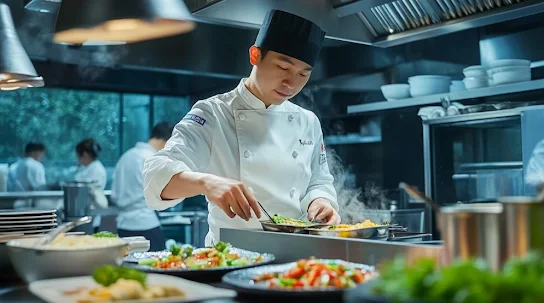Chinese Food in American Restaurants: A Unique Culinary Fusion
Chinese cuisine has become integral to American food
culture, evolving into a distinctive fusion that blends traditional Chinese
flavors with American tastes. The journey of Chinese food in the United States
is a story of adaptation, innovation, and cultural exchange. Today,
Chinese-American restaurants are ubiquitous, offering a diverse menu that
caters to a wide audience.
The History of Chinese Food in America:
Chinese food first arrived in the United States during the
mid-19th century with Chinese immigrants, particularly those who came to work
on the railroads and in gold mines. Settling mainly in California, these
immigrants introduced their culinary traditions, which gradually gained
popularity among non-Chinese Americans. However, due to limited access to
authentic ingredients, Chinese cooks adapted their recipes using locally
available products, creating a unique fusion of flavors that would eventually define
Chinese-American cuisine.
One of the first Chinese restaurants in America was opened
in San Francisco in the 1840s. Over time, Chinese eateries expanded across the
country, and by the early 20th century, they had become popular dining
destinations. Despite facing discrimination and restrictive immigration
policies, Chinese restaurateurs persevered, contributing to the development of
an industry that now plays a significant role in American dining culture.
The Evolution of Chinese-American Cuisine:
Unlike traditional Chinese cuisine, which varies greatly by
region (e.g., Sichuan, Cantonese, Hunan), Chinese-American food has been
adapted to suit the Western palate. Many dishes that are staples in American
Chinese restaurants are not commonly found in China. Instead, they were created
in the U.S. to appeal to local tastes, featuring sweeter sauces, less spice,
and deep-fried elements.
Some notable differences between authentic Chinese food and
its Americanized counterpart include:
- Use
of Sugar and Cornstarch: Many Chinese-American dishes are sweeter and
thicker in consistency compared to their traditional counterparts.
- Meat
Emphasis: Authentic Chinese cuisine often focuses on vegetables, tofu,
and seafood, while Americanized versions highlight chicken, beef, and
pork.
- Deep-Frying:
Dishes such as General Tso’s Chicken and Sweet and Sour Chicken rely
heavily on deep-frying, a cooking technique not as commonly used in
traditional Chinese cooking.
Popular Chinese Dishes in American Restaurants:
Several iconic Chinese-American dishes have become household
names, often differing significantly from their traditional inspirations. Some
of the most popular dishes include:
1. General Tso’s Chicken:
General Tso’s Chicken is perhaps the most famous
Chinese-American dish. It consists of deep-fried chicken pieces coated in a
sweet and tangy sauce. Despite its popularity in the U.S., this dish is
virtually unknown in China.
2. Orange Chicken:
Similar to General Tso’s Chicken, Orange Chicken features
battered and fried chicken in a citrusy, sweet sauce. This dish gained
widespread popularity through fast-food chains like Panda Express.
3. Chop Suey:
Chop Suey, a dish consisting of stir-fried meat, eggs, and
vegetables in a thick sauce, is an entirely American creation. Though its
origins are debated, it is believed to have been invented by Chinese immigrants
in California during the 19th century.
4. Egg Rolls:
Egg rolls, the deep-fried cousin of spring rolls, are
another staple of Chinese-American cuisine. These crispy appetizers, filled
with cabbage, pork, and other ingredients, are not common in traditional
Chinese cuisine.
5. Fried Rice:
While fried rice is a staple in many Asian cuisines, the
American version is often heavier on soy sauce and includes ingredients such as
ham, peas, and carrots, making it distinct from its Chinese counterpart.
6. Crab Rangoon:
Crab Rangoon is a deep-fried dumpling filled with a mixture
of cream cheese, imitation crab, and seasonings. This dish has no direct
equivalent in China, as dairy products are not traditionally a major component
of Chinese cuisine.
The Influence of Chinese-American Cuisine:
The popularity of Chinese-American food has influenced the
broader American culinary landscape in several ways:
- Expansion
of Asian Cuisine: The success of Chinese food paved the way for other
Asian cuisines, such as Thai, Japanese, and Vietnamese, to gain traction
in the U.S.
- Fast-Food
Adaptations: Chains like Panda Express have adapted Chinese-American
food into a fast-food format, making it more accessible to a wider
audience.
- Fusion
Trends: Chinese flavors have merged with other culinary traditions,
leading to the rise of dishes like Chinese tacos, sushi burritos, and kung
pao pasta.
Regional Variations of Chinese Food in America:
Different regions of the United States have developed their
own take on Chinese food, influenced by local ingredients and culinary
preferences:
- New
York City: Home to some of the oldest Chinese restaurants in the U.S.,
offering both authentic and Americanized Chinese dishes.
- San
Francisco: Features a mix of traditional Cantonese cuisine and modern
Chinese-American innovations.
- The
Midwest and South: Often showcase sweeter and more deep-fried
variations of Chinese dishes.
Health Concerns and Adaptations:
While Chinese-American cuisine is beloved, it has also been
criticized for its high sodium, sugar, and calorie content. In response, many
restaurants have started offering healthier options, including:
- Steamed
dishes instead of fried options
- Brown
rice as an alternative to white rice
- Lighter
sauces with reduced sugar and sodium
- Vegetarian
and vegan-friendly menu items
The Future of Chinese Food in America:
As American diners become more interested in authentic
global flavors, there has been a growing demand for authentic regional
Chinese cuisine alongside Chinese-American dishes. Modern Chinese
restaurants in cities like New York, Los Angeles, and San Francisco are now
offering dishes from Sichuan, Yunnan, and Hunan provinces, catering to a more
adventurous clientele.
Moreover, innovations in plant-based cuisine have led to a
rise in vegetarian and vegan Chinese dishes, making the cuisine more accessible
to a broader audience. Food delivery services and meal kits have also helped
introduce home cooks to Chinese ingredients and techniques, further solidifying
the cuisine’s place in American homes.
Conclusion:
#chineseamericancuisine #fusionfood #generaltsoschicken #orangechicken
#chopsuey #eggrolls #friedrice #crabrangoon #authenticchinesefood #americanizedchinesefood
#chineserestaurants #takeoutfood #fastfoodChinese #culturaladaptation #foodinnovation







0 Comments